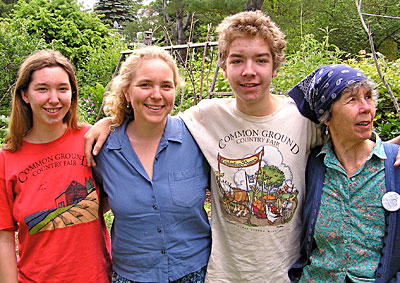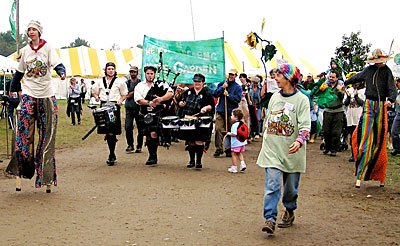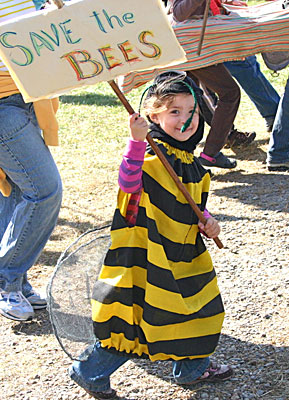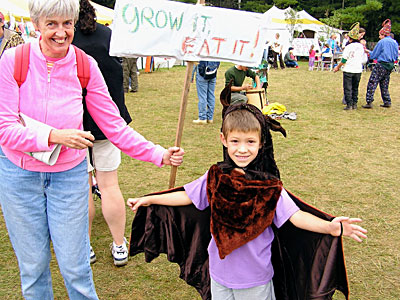 |
| The Children’s Vegetable Garden Parade at the Common Ground Country Fair. Shown here: the potato costume. English photo. |
Twenty Years of the Children’s Garden Parade at Common Ground
By Jean English
In 1990, MOFGA member Beedy Parker wanted to spread the message that the Common Ground Country Fair “means common ground. There’s a lot of space for all kinds of people at the Fair.” So she created a parade of vegetables and garden creatures, “something that would say we all belong in the garden,” inspired by the parades of Vermont’s Bread & Puppet Theater.
Seeds of the idea had already germinated. “Two years before, Martha Gottlieb [now Exhibition Hall co-coordinator] and I both made tomato costumes,” says Parker, “and we had people walking around the Fair carrying a pole with a sign saying, ‘Do you know what’s on this tomato?’ We used those tomatoes in the parade.”
Parker and Susan Murata made other costumes from recycled materials, and students from the Riley School in Rockport were the seminal parade group two decades ago.
“I wanted to have the kids do some acting out,” says Parker, but she soon realized that “putting on costumes was quite enough” for the twice-daily affair.
Garden Veggies
Early costumes included a carrot, tomatoes, eggplant, pea pod, pumpkin, Brussels sprouts, “and something that was either a cabbage or a lettuce – nobody knows,” says Parker. “Corn – that was a lot of work. Potato – that was my favorite, because you can see through it.
“We’ve never had a cucumber,” says Parker. “Green beans are too hard.”
 |
| Beedy Parker started the Children’s Vegetable Garden Parade to convey the idea that we all live in the garden. English photo. |
 |
| Parker’s family helps organize and lead the parade now. From left to right, Celeste, Daaby, Pepin and Beedy. English photo. |
An early parade coordinator, Genny Keller, made little strawberry and blueberry hats, so parents could easily “dress” very young children for the parade.
Sometimes people combine bits of costumes. “I think of those as genetically engineered,” says Daaby Tingle, Parker’s daughter and co-coordinator of the parade.
Compost and Critters
Garden creatures have always joined the parade. They now include a praying mantis, caterpillar, slug, worms, monarch butterflies, a chicken and a crow – and a simple cat costume from Florence Marshall – because, Parker says, “Cat’s like to get in the garden!” – even if they don’t “belong” there.
A spider, two flying insects on long sticks and two sunflowers bring a vertical element to the parade. A compost pile made of rags tied onto a chicken wire frame adds depth.
Sheila Carter, who led the parade for years, made the pig, butterfly and bee costumes. “She was a great, staunch supporter from early on, and a great spirit,” says Parker.
Store-bought costumes, says Tingle, generally don’t fit in with the parade’s homemade costumes using mostly recycled/re-used materials, which better reflect the self-sufficient/buy local/self-empowerment philosophy of the Fair. Exceptions are two little frogs and ladybugs that were donated; and Parker was able to cover a pop-eyed, commercial toy snake with fabric “skin” and change its head to create a garter snake.
Tingle made a morning glory flower fairy, “partly because I wanted that kind of spiritual fairy piece in the parade, and because a lot of little girls want to come and dress up. We could probably have an army of flower fairies and they would all get used, but we’re kind of at the maximum for getting people dressed and lined up – and then you have to get them out before they start thinking, ‘Oh, maybe I don’t want to be in the parade after all.’ Or before they jump in the hay pile with their costumes on.”
Tingle’s daughter, Celeste Mittelhauser, says she’s “really partial to the slug costume. I think it looks cool.” Tingle’s son, Pepin, recalls when the slug dragged a slime trail along with it; and Parker mentions “one kid – I thought he was depressed,” because he was moping along in the slug costume. “Then I realized that he was being a slug – a very good slug.”
 |
| The parade meets in the Children’s Area at 10:15 and 2:15 each day of the Fair to dress for the 10:30 and 2:30 parades. English photo. |
 |
| Celeste (left) and Pepin (right) on stilts, with grandmother Beedy Parker leading the parade. English photo. |
Celeste and Pepin, who paraded with their parents when they were young (both preferring the monarch butterfly costumes then), later became stilt walkers leading the parade – Celeste beginning around 2000; Pepin a few years later (although he misses the parade on Friday, when he’s at his beeswax candle booth in the Youth Enterprise Zone). Their cousin Helen joined them in 2009. Earlier, Genny Keller’s son and his friend stilt walked in the parade.
Essential Sound
“You really want a loud instrument out front to make people pay attention and get out of the way,” says Tingle, so Parker recruits musicians. “The accordion player was one of the best early ones,” she says. Now musicians “sort of come with the family,” as Celeste’s boyfriend and his brother and father all play bagpipes.
All four family members say they’d like to have more musicians. “I would love to have steel drums,” says Parker. “And accordions are wonderful. And bagpipes.”
Parker recalls a favorite participant – “a tall, skinny hippie guy who had hair like a lion, and bongos, and he got out there with his lion hair, and he was like the sun leading the parade, just beautiful.”
Parade Mechanics
Some 75 costumes are available now, but the parade also includes people accompanying their children, carrying signs saying things like “Grow Organic!” and “Local Food,” and using noisemakers.
Most costumes stay on site during the year, and on the Wednesday before the Fair, Tingle and her children and a friend get them out of storage. They spend Thursday setting up and mending, sometimes with other volunteers. Tingle and Parker check costumes during and between parades, and take some home to mend or rebuild over winter.
“It’s funny to tell your friends that you can’t come over their house because you’re mending a compost heap,” says Pepin.
Tingle says that coordinating the parade is “a relatively cushy job at the Fair. There’s a lot of setup and a lot of breakdown, and some work over the winter, but during the actual Fair time, you can still see the Fair.”
 |
| The compost pile. English photo. |
 |
| Carrot and pumpkin kids. English photo. |
The parade does not go out in the rain, because wet costumes would take too long to dry, canceling subsequent parades.
Parker initially tried to have the parade cover the whole fair, but she quickly realized that younger kids wouldn’t be able to walk that far. Tingle wonders if a handpicked group might wear the wilder costumes and cover the grounds.
“The wild zucchini!” says Parker. “You could have a troupe of teenagers that would put together an act and go out and perform.”
Parading through crowds in the food areas is exciting – especially on stilts, says Pepin. “Some people are so enthusiastic,” says Tingle, “like Bob and Mia [at Sewall’s Cider booth]. They’re always clapping and saying things like ‘Yay frog!’”
Every parade needs someone in front asking people to move, and someone making sure the end of the parade doesn’t get too stretched or bunched. “Abi Morrison is really good at clearing the path in front,” says Tingle. A bass drum, donated by Jack Kertesz (who plants many of the vegetable display gardens on the grounds) and played by Tingle or a hardy parade participant, brings up the end of the parade – using, apropos of the Fair, gourds for drumsticks.
Parade participants have been excellent about returning costumes. “Once the frog costume showed up in the lost and found at the information booth,” says Tingle, “but that’s the farthest anything’s ever gotten.”
Pepin attributes this to his mother and grandmother’s loud reminder: “Everyone bring your costumes back!” The coordinators set out cards with pictures of the costumes (which Parker drew) to show where to return each one.
The Cycle Continues
Celeste enjoys hearing kids’ stories after parades – about strutting around as a chicken, for instance. Pepin counters that it can be frustrating to see a slug doing a tap dance.
 |
 |
| The pea pod. English photo. | Save the bees. English photo. |
 |
 |
| The wild zucchini tours the tables in the Exhibition Hall. English photo. | A bat. English photo. |
Whatever the story, “I keep coming back to ‘We all belong in the garden,’” says Tingle. “The parade is like the mascot of the whole Fair. After 20 years, a lot of people have grown up with it.”
And like the cycles in a garden, those people return with their children, adds Parker – new slugs or peas or sunflowers lighting up the Fair.
Make Your Own Costume
The parade inspired a coloring book (available through MOFGA’s Country Store, at the Fair and at www.mofga.org) coordinated by artist Genny Keller, who led the parade for years (and created the crow and tomato plant poster design for the 2004 Fair). Five artists – Keller, Parker, Toki Oshima, Leane Boynton and Kirsten Salvatore – drew the costumes, and the book contains directions for making them. Many are built with chicken wire, with bubble pack taped on the outside and a skin of fabric outside the bubble pack, so they look soft and fleshy. Others are just fabric.
Costumes to Loan
These parade enthusiasts have created a set of costumes to loan to teachers and others who would like to use them for their own events. The costumes are jointly owned by the Flannel Shirt Project (in memory of Joel Cartwright, who was deeply involved in teaching gardening and sustainable living) and are managed by Kathy Cartwright, a teacher who uses the costumes with her own classes. To borrow these, please call Cartwright at 832-5584.
